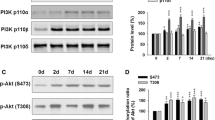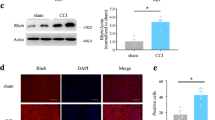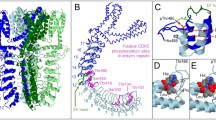Abstract
The collapsin response mediator protein 2 (CRMP2) has emerged as a central node in assembling nociceptive signaling complexes involving voltage-gated ion channels. Concerted actions of post-translational modifications, phosphorylation and SUMOylation, of CRMP2 contribute to regulation of pathological pain states. In the present study, we demonstrate a novel role for CRMP2 in spinal nociceptive transmission. We found that, of six possible post-translational modifications, three phosphorylation sites on CRMP2 were critical for regulating calcium influx in dorsal root ganglion sensory neurons. Of these, only CRMP2 phosphorylated at serine 522 by cyclin-dependent kinase 5 (Cdk5) contributed to spinal neurotransmission in a bidirectional manner. Accordingly, expression of a non-phosphorylatable CRMP2 (S522A) decreased the frequency of spontaneous excitatory postsynaptic currents (sEPSCs), whereas expression of a constitutively phosphorylated CRMP2 (S522D) increased the frequency of sEPSCs. The presynaptic nature of CRMP2’s actions was further confirmed by pharmacological antagonism of Cdk5-mediated CRMP2 phosphorylation with S-N-benzy-2-acetamido-3-methoxypropionamide ((S)-lacosamide; (S)-LCM) which (i) decreased sEPSC frequency, (ii) increased paired-pulse ratio, and (iii) reduced the presynaptic distribution of CaV2.2 and NaV1.7, two voltage-gated ion channels implicated in nociceptive signaling. (S)-LCM also inhibited depolarization-evoked release of the pro-nociceptive neurotransmitter calcitonin gene-related peptide (CGRP) in the spinal cord. Increased CRMP2 phosphorylation in rats with spared nerve injury (SNI) was decreased by intrathecal administration of (S)-LCM resulting in a loss of presynaptic localization of CaV2.2 and NaV1.7. Together, these findings indicate that CRMP2 regulates presynaptic excitatory neurotransmission in spinal cord and may play an important role in regulating pathological pain. Novel targeting strategies to inhibit CRMP2 phosphorylation by Cdk5 may have great potential for the treatment of chronic pain.








Similar content being viewed by others
References
Costigan M, Scholz J, Woolf CJ (2009) Neuropathic pain: a maladaptive response of the nervous system to damage. Annu Rev Neurosci 32:1–32.https://doi.org/10.1146/annurev.neuro.051508.135531
Moulin D, Boulanger A, Clark AJ, Clarke H, Dao T, Finley GA, Furlan A, Gilron I et al (2014) Pharmacological management of chronic neuropathic pain: revised consensus statement from the Canadian Pain Society. Pain Res Manag 19(6):328–335
Price TJ, Basbaum AI, Bresnahan J, Chambers JF, De Koninck Y, Edwards RR, Ji RR, Katz J et al (2018) Transition to chronic pain: opportunities for novel therapeutics. Nat Rev Neurosci 19:383–384. https://doi.org/10.1038/s41583-018-0012-5
Todd AJ (2010) Neuronal circuitry for pain processing in the dorsal horn. Nat Rev Neurosci 11(12):823–836. https://doi.org/10.1038/nrn2947
D'Mello R, Dickenson AH (2008) Spinal cord mechanisms of pain. Br J Anaesth 101(1):8–16.https://doi.org/10.1093/bja/aen088
Latremoliere A, Woolf CJ (2009) Central sensitization: a generator of pain hypersensitivity by central neural plasticity. J Pain 10(9):895–926. https://doi.org/10.1016/j.jpain.2009.06.012
Divito CB, Underhill SM (2014) Excitatory amino acid transporters: roles in glutamatergic neurotransmission. Neurochem Int 73:172–180. https://doi.org/10.1016/j.neuint.2013.12.008
Dolphin AC (2012) Calcium channel auxiliary alpha2delta and beta subunits: trafficking and one step beyond. Nat Rev Neurosci 13(8):542–555. https://doi.org/10.1038/nrn3311
Khanna R, Zougman A, Stanley EF (2007) A proteomic screen for presynaptic terminal N-type calcium channel (CaV2.2) binding partners. J Biochem Mol Biol 40(3):302–314
Chi XX, Schmutzler BS, Brittain JM, Hingtgen CM, Nicol GD, Khanna R (2009) Regulation of N-type voltage-gated calcium (CaV2.2) channels and transmitter release by collapsin response mediator protein-2 (CRMP-2) in sensory neurons. J Cell Sci 122(23):4351–4362
Brittain JM, Piekarz AD, Wang Y, Kondo T, Cummins TR, Khanna R (2009) An atypical role for collapsin response mediator protein 2 (CRMP-2) in neurotransmitter release via interaction with presynaptic voltage-gated calcium channels. J Biol Chem 284(45):31375–31390. https://doi.org/10.1074/jbc.M109.009951
Brittain JM, Duarte DB, Wilson SM, Zhu W, Ballard C, Johnson PL, Liu N, Xiong W et al (2011) Suppression of inflammatory and neuropathic pain by uncoupling CRMP-2 from the presynaptic Ca(2)(+) channel complex. Nat Med 17(7):822–829. https://doi.org/10.1038/nm.2345
Francois-Moutal L, Wang Y, Moutal A, Cottier KE, Melemedjian OK, Yang X, Wang Y, Ju W et al (2015) A membrane-delimited N-myristoylated CRMP2 peptide aptamer inhibits CaV2.2 trafficking and reverses inflammatory and postoperative pain behaviors. Pain 156(7):1247–1264. https://doi.org/10.1097/j.pain.0000000000000147
Moutal A, Li W, Wang Y, Ju W, Luo S, Cai S, Francois-Moutal L, Perez-Miller S et al (2017) Homology-guided mutational analysis reveals the functional requirements for antinociceptive specificity of collapsin response mediator protein 2-derived peptides. Br J Pharmacol 175:2244–2260. https://doi.org/10.1111/bph.13737
Piekarz AD, Due MR, Khanna M, Wang B, Ripsch MS, Wang R, Meroueh SO, Vasko MR et al (2012) CRMP-2 peptide mediated decrease of high and low voltage-activated calcium channels, attenuation of nociceptor excitability, and anti-nociception in a model of AIDS therapy-induced painful peripheral neuropathy. Mol Pain 8(1):54. https://doi.org/10.1186/1744-8069-8-54
Ripsch MS, Ballard CJ, Khanna M, Hurley JH, White FA, Khanna R (2012) A peptide uncoupling CRMP-2 from the presynaptic Ca2+ channel complex demonstrate efficacy in animal models of migraine and AIDS therapy-induced neuropathy. Transl Neurosci 3(1):1–8
Khanna R, Wilson SM, Brittain JM, Weimer J, Sultana R, Butterfield A, Hensley K (2012) Opening Pandora’s jar: a primer on the putative roles of CRMP2 in a panoply of neurodegenerative, sensory and motor neuron, and central disorders. Future Neurol 7(6):749–771. https://doi.org/10.2217/fnl.12.68
Quach TT, Honnorat J, Kolattukudy PE, Khanna R, Duchemin AM (2015) CRMPs: critical molecules for neurite morphogenesis and neuropsychiatric diseases. Mol Psychiatry 20(9):1037–1045. https://doi.org/10.1038/mp.2015.77
Moutal A, Francois-Moutal L, Brittain JM, Khanna M, Khanna R (2014) Differential neuroprotective potential of CRMP2 peptide aptamers conjugated to cationic, hydrophobic, and amphipathic cell penetrating peptides. Front Cell Neurosci 8:471. https://doi.org/10.3389/fncel.2014.00471
Dustrude ET, Wilson SM, Ju W, Xiao Y, Khanna R (2013) CRMP2 protein SUMOylation modulates NaV1.7 channel trafficking. J Biol Chem 288(34):24316–24331. https://doi.org/10.1074/jbc.M113.474924
Brustovetsky T, Pellman JJ, Yang XF, Khanna R, Brustovetsky N (2014) Collapsin response mediator protein 2 (CRMP2) interacts with N-methyl-D-aspartate (NMDA) receptor and Na+/Ca2+ exchanger and regulates their functional activity. J Biol Chem 289(11):7470–7482. https://doi.org/10.1074/jbc.M113.518472
Dustrude ET, Moutal A, Yang X, Wang Y, Khanna M, Khanna R (2016) Hierarchical CRMP2 posttranslational modifications control NaV1.7 function. Proc Natl Acad Sci 113(52):E8443–E8452. https://doi.org/10.1073/pnas.1610531113
Dustrude ET, Perez-Miller S, Francois-Moutal L, Moutal A, Khanna M, Khanna R (2017) A single structurally conserved SUMOylation site in CRMP2 controls NaV1.7 function. Channels (Austin) 11:316–328. https://doi.org/10.1080/19336950.2017.1299838
Francois-Moutal L, Dustrude ET, Wang Y, Brustovetsky T, Dorame A, Ju W, Moutal A, Perez-Miller S et al (2018) Inhibition of the Ubc9 E2 SUMO-conjugating enzyme-CRMP2 interaction decreases NaV1.7 currents and reverses experimental neuropathic pain. Pain. https://doi.org/10.1097/j.pain.0000000000001294
Ju W, Li Q, Wilson SM, Brittain JM, Meroueh L, Khanna R (2013) SUMOylation alters CRMP2 regulation of calcium influx in sensory neurons. Channels 7(3):153–159
Moutal A, Dustrude ET, Largent-Milnes TM, Vanderah TW, Khanna M, Khanna R (2017) Blocking CRMP2 SUMOylation reverses neuropathic pain. Mol Psychiatry. https://doi.org/10.1038/mp.2017.117
Cole AR, Causeret F, Yadirgi G, Hastie CJ, McLauchlan H, McManus EJ, Hernandez F, Eickholt BJ et al (2006) Distinct priming kinases contribute to differential regulation of collapsin response mediator proteins by glycogen synthase kinase-3 in vivo. J Biol Chem 281(24):16591–16598. https://doi.org/10.1074/jbc.M513344200
Yoshimura T, Kawano Y, Arimura N, Kawabata S, Kikuchi A, Kaibuchi K (2005) GSK-3beta regulates phosphorylation of CRMP-2 and neuronal polarity. Cell 120(1):137–149. https://doi.org/10.1016/j.cell.2004.11.012
Arimura N, Inagaki N, Chihara K, Menager C, Nakamura N, Amano M, Iwamatsu A, Goshima Y et al (2000) Phosphorylation of collapsin response mediator protein-2 by Rho-kinase. Evidence for two separate signaling pathways for growth cone collapse. J Biol Chem 275(31):23973–23980. https://doi.org/10.1074/jbc.M001032200
Varrin-Doyer M, Vincent P, Cavagna S, Auvergnon N, Noraz N, Rogemond V, Honnorat J, Moradi-Ameli M et al (2009) Phosphorylation of collapsin response mediator protein 2 on Tyr-479 regulates CXCL12-induced T lymphocyte migration. J Biol Chem 284(19):13265–13276. https://doi.org/10.1074/jbc.M807664200
Uchida Y, Ohshima T, Yamashita N, Ogawara M, Sasaki Y, Nakamura F, Goshima Y (2009) Semaphorin3A signaling mediated by Fyn-dependent tyrosine phosphorylation of collapsin response mediator protein 2 at tyrosine 32. J Biol Chem 284(40):27393–27401. https://doi.org/10.1074/jbc.M109.000240
Ji RR, Kawasaki Y, Zhuang ZY, Wen YR, Zhang YQ (2007) Protein kinases as potential targets for the treatment of pathological pain. Handb Exp Pharmacol 177:359–389
Uchida Y, Ohshima T, Sasaki Y, Suzuki H, Yanai S, Yamashita N, Nakamura F, Takei K et al (2005) Semaphorin3A signalling is mediated via sequential Cdk5 and GSK3beta phosphorylation of CRMP2: implication of common phosphorylating mechanism underlying axon guidance and Alzheimer’s disease. Genes Cells 10(2):165–179. https://doi.org/10.1111/j.1365-2443.2005.00827.x
Brittain JM, Wang Y, Eruvwetere O, Khanna R (2012) Cdk5-mediated phosphorylation of CRMP-2 enhances its interaction with CaV2.2. FEBS Lett 586(21):3813–3818. https://doi.org/10.1016/j.febslet.2012.09.022
Moutal A, Cai S, Luo S, Voisin R, Khanna R (2018) CRMP2 is necessary for neurofibromatosis type 1 related pain. Channels 12(1):47–50. https://doi.org/10.1080/19336950.2017.1370524
Moutal A, Luo S, Largent-Milnes TM, Vanderah TW, Khanna R (2018) Cdk5-mediated CRMP2 phosphorylation is necessary and sufficient for peripheral neuropathic pain. Neurobiol Pain. https://doi.org/10.1016/j.ynpai.2018.07.003
Hergenroeder GW, Redell JB, Choi HA, Schmitt L, Donovan W, Francisco GE, Schmitt K, Moore AN et al (2018) Increased levels of circulating glial fibrillary acidic protein and collapsin response mediator protein-2 autoantibodies in the acute stage of spinal cord injury predict the subsequent development of neuropathic pain. J Neurotrauma 35:2530–2539. https://doi.org/10.1089/neu.2018.5675
Moutal A, Yang X, Li W, Gilbraith KB, Luo S, Cai S, Francois-Moutal L, Chew LA et al (2017) CRISPR/Cas9 editing of Nf1 gene identifies CRMP2 as a therapeutic target in neurofibromatosis type 1-related pain that is reversed by (S)-lacosamide. Pain 158(12):2301–2319. https://doi.org/10.1097/j.pain.0000000000001002
Moutal A, Chew LA, Yang X, Wang Y, Yeon SK, Telemi E, Meroueh S, Park KD et al (2016) (S)-Lacosamide inhibition of CRMP2 phosphorylation reduces postoperative and neuropathic pain behaviors through distinct classes of sensory neurons identified by constellation pharmacology. Pain 157(7):1448–1463. https://doi.org/10.1097/j.pain.0000000000000555
Zhang SH, Yu J, Lou GD, Tang YY, Wang RR, Hou WW, Chen Z (2016) Widespread pain sensitization after partial infraorbital nerve transection in MRL/MPJ mice. Pain 157(3):740–749. https://doi.org/10.1097/j.pain.0000000000000432
Duan B, Cheng L, Bourane S, Britz O, Padilla C, Garcia-Campmany L, Krashes M, Knowlton W et al (2014) Identification of spinal circuits transmitting and gating mechanical pain. Cell 159(6):1417–1432. https://doi.org/10.1016/j.cell.2014.11.003
Moutal A, Sun L, Yang X, Li W, Cai S, Luo S, Khanna R (2018) CRMP2-neurofibromin interface drives NF1-related pain. Neuroscience 381:79–90. https://doi.org/10.1016/j.neuroscience.2018.04.002
Moutal A, Wang Y, Yang X, Ji Y, Luo S, Dorame A, Bellampalli SS, Chew LA et al (2017) Dissecting the role of the CRMP2-neurofibromin complex on pain behaviors. Pain 158(11):2203–2221. https://doi.org/10.1097/j.pain.0000000000001026
Xie JY, Chew LA, Yang X, Wang Y, Qu C, Wang Y, Federici LM, Fitz SD et al (2016) Sustained relief of ongoing experimental neuropathic pain by a CRMP2 peptide aptamer with low abuse potential. Pain 157(9):2124–2140. https://doi.org/10.1097/j.pain.0000000000000628
Moutal A, Eyde N, Telemi E, Park KD, Xie JY, Dodick DW, Porreca F, Khanna R (2016) Efficacy of (S)-lacosamide in preclinical models of cephalic pain. Pain Rep 1(1):e565. https://doi.org/10.1097/PR9.0000000000000565
Moutal A, Francois-Moutal L, Perez-Miller S, Cottier K, Chew LA, Yeon SK, Dai J, Park KD et al (2016) (S)-Lacosamide binding to collapsin response mediator protein 2 (CRMP2) regulates CaV2.2 activity by subverting its phosphorylation by Cdk5. Mol Neurobiol 53(3):1959–1976. https://doi.org/10.1007/s12035-015-9141-2
Ibrahim MM, Patwardhan A, Gilbraith KB, Moutal A, Yang X, Chew LA, Largent-Milnes T, Malan TP et al (2017) Long-lasting antinociceptive effects of green light in acute and chronic pain in rats. Pain 158(2):347–360. https://doi.org/10.1097/j.pain.0000000000000767
Chi XX, Schmutzler BS, Brittain JM, Wang Y, Hingtgen CM, Nicol GD, Khanna R (2009) Regulation of N-type voltage-gated calcium channels (Cav2.2) and transmitter release by collapsin response mediator protein-2 (CRMP-2) in sensory neurons. J Cell Sci 122(Pt 23):4351–4362. https://doi.org/10.1242/jcs.053280
Pacchioni AM, Vallone J, Worley PF, Kalivas PW (2009) Neuronal pentraxins modulate cocaine-induced neuroadaptations. J Pharmacol Exp Ther 328(1):183–192. https://doi.org/10.1124/jpet.108.143115
Duan JH, Hodgdon KE, Hingtgen CM, Nicol GD (2014) N-type calcium current, Cav2.2, is enhanced in small-diameter sensory neurons isolated from Nf1+/− mice. Neuroscience 270:192–202. https://doi.org/10.1016/j.neuroscience.2014.04.021
Wilson SM, Toth PT, Oh SB, Gillard SE, Volsen S, Ren D, Philipson LH, Lee EC et al (2000) The status of voltage-dependent calcium channels in alpha 1E knock-out mice. JNeurosci 20(23):8566–8571
Wheeler DG, Groth RD, Ma H, Barrett CF, Owen SF, Safa P, Tsien RW (2012) Ca(V)1 and Ca(V)2 channels engage distinct modes of Ca(2+) signaling to control CREB-dependent gene expression. Cell 149(5):1112–1124
McIntosh JM, Corpuz GO, Layer RT, Garrett JE, Wagstaff JD, Bulaj G, Vyazovkina A, Yoshikami D et al (2000) Isolation and characterization of a novel conus peptide with apparent antinociceptive activity. J Biol Chem 275(42):32391–32397. https://doi.org/10.1074/jbc.M003619200
Wang Y, Brittain JM, Jarecki BW, Park KD, Wilson SM, Wang B, Hale R, Meroueh SO et al (2010) In silico docking and electrophysiological characterization of lacosamide binding sites on collapsin response mediator protein-2 identifies a pocket important in modulating sodium channel slow inactivation. J Biol Chem 285(33):25296–25307. https://doi.org/10.1074/jbc.M110.128801
Zucker RS, Regehr WG (2002) Short-term synaptic plasticity. Annu Rev Physiol 64:355–405. https://doi.org/10.1146/annurev.physiol.64.092501.114547
Zhang Y, Xiao X, Zhang XM, Zhao ZQ, Zhang YQ (2012) Estrogen facilitates spinal cord synaptic transmission via membrane-bound estrogen receptors: implications for pain hypersensitivity. J Biol Chem 287(40):33268–33281. https://doi.org/10.1074/jbc.M112.368142
Schou WS, Ashina S, Amin FM, Goadsby PJ, Ashina M (2017) Calcitonin gene-related peptide and pain: a systematic review. J Headache Pain 18(1):34. https://doi.org/10.1186/s10194-017-0741-2
Nitzan-Luques A, Devor M, Tal M (2011) Genotype-selective phenotypic switch in primary afferent neurons contributes to neuropathic pain. Pain 152(10):2413–2426. https://doi.org/10.1016/j.pain.2011.07.012
Lee SE, Kim JH (2007) Involvement of substance P and calcitonin gene-related peptide in development and maintenance of neuropathic pain from spinal nerve injury model of rat. Neurosci Res 58(3):245–249. https://doi.org/10.1016/j.neures.2007.03.004
Decosterd I, Woolf CJ (2000) Spared nerve injury: an animal model of persistent peripheral neuropathic pain. Pain 87(2):149–158
Cizkova D, Marsala J, Lukacova N, Marsala M, Jergova S, Orendacova J, Yaksh TL (2002) Localization of N-type Ca2+ channels in the rat spinal cord following chronic constrictive nerve injury. Exp Brain Res 147(4):456–463. https://doi.org/10.1007/s00221-002-1217-3
Ip JP, Fu AK, Ip NY (2014) CRMP2: functional roles in neural development and therapeutic potential in neurological diseases. Neuroscientist 20:589–598. https://doi.org/10.1177/1073858413514278
Chew LA, Khanna R (2018) CRMP2 and voltage-gated ion channels: potential roles in neuropathic pain. Neuronal Signaling 2:16. https://doi.org/10.1042/NS20170220
Moutal A, Eyde N, Telemi E, Park KD, Xie JY, Dodick DW, Porreca F, Khanna R (2016) Efficacy of (S)-lacosamide in preclinical models of cephalic pain. Pain Rep 1(1):1–10. https://doi.org/10.1097/PR9.0000000000000565
Marques JM, Rodrigues RJ, Valbuena S, Rozas JL, Selak S, Marin P, Aller MI, Lerma J (2013) CRMP2 tethers kainate receptor activity to cytoskeleton dynamics during neuronal maturation. J Neurosci 33(46):18298–18310. https://doi.org/10.1523/JNEUROSCI.3136-13.2013
Petratos S, Ozturk E, Azari MF, Kenny R, Lee JY, Magee KA, Harvey AR, McDonald C et al (2012) Limiting multiple sclerosis related axonopathy by blocking Nogo receptor and CRMP-2 phosphorylation. Brain 135(Pt 6):1794–1818. https://doi.org/10.1093/brain/aws100
Zhou Y, Danbolt NC (2014) Glutamate as a neurotransmitter in the healthy brain. J Neural Transm 121(8):799–817. https://doi.org/10.1007/s00702-014-1180-8
Gemes G, Bangaru ML, Wu HE, Tang Q, Weihrauch D, Koopmeiners AS, Cruikshank JM, Kwok WM et al (2011) Store-operated Ca2+ entry in sensory neurons: functional role and the effect of painful nerve injury. J Neurosci 31(10):3536–3549. https://doi.org/10.1523/JNEUROSCI.5053-10.2011
Kadoyama K, Matsuura K, Nakamura-Hirota T, Takano M, Otani M, Matsuyama S (2015) Changes in the expression of collapsin response mediator protein-2 during synaptic plasticity in the mouse hippocampus. J Neurosci Res 93(11):1684–1692. https://doi.org/10.1002/jnr.23626
Zhang J, Zhao B, Zhu X, Li J, Wu F, Li S, Gong X, Cha C et al (2018) Phosphorylation and SUMOylation of CRMP2 regulate the formation and maturation of dendritic spines. Brain Res Bull 139:21–30. https://doi.org/10.1016/j.brainresbull.2018.02.004
Chai Z, Wang C, Huang R, Wang Y, Zhang X, Wu Q, Wang Y, Wu X et al (2017) CaV2.2 gates calcium-independent but voltage-dependent secretion in mammalian sensory neurons. Neuron 96(6):1317–1326 e1314. https://doi.org/10.1016/j.neuron.2017.10.028
Fioravante D, Regehr WG (2011) Short-term forms of presynaptic plasticity. Curr Opin Neurobiol 21(2):269–274. https://doi.org/10.1016/j.conb.2011.02.003
Tomoyose O, Kodama D, Ono H, Tanabe M (2014) Presynaptic inhibitory effects of fluvoxamine, a selective serotonin reuptake inhibitor, on nociceptive excitatory synaptic transmission in spinal superficial dorsal horn neurons of adult mice. J Pharmacol Sci 126(2):136–145
Meng J, Wang J, Lawrence G, Dolly JO (2007) Synaptobrevin I mediates exocytosis of CGRP from sensory neurons and inhibition by botulinum toxins reflects their anti-nociceptive potential. J Cell Sci 120(Pt 16):2864–2874. https://doi.org/10.1242/jcs.012211
McCoy ES, Taylor-Blake B, Street SE, Pribisko AL, Zheng J, Zylka MJ (2013) Peptidergic CGRPalpha primary sensory neurons encode heat and itch and tonically suppress sensitivity to cold. Neuron 78(1):138–151. https://doi.org/10.1016/j.neuron.2013.01.030
Funding
This work was supported by a grant from the National Natural Science Foundation of China (81603088) to J.Y., a grant from the National Institutes of Health to JMW (R01NS082283), National Institutes of Health awards (R01NS098772 from the National Institute of Neurological Disorders and Stroke and R01DA042852 from the National Institute on Drug Abuse to R.K.), and a Neurofibromatosis New Investigator Award from the Department of Defense Congressionally Directed Military Medical Research and Development Program (NF1000099) to R.K. S.S.B. and N.Y.N.P. were supported by funds to the Undergraduate Biology Research Program from the University of Arizona’s Senior Vice President for Research’s office, and the University of Arizona’s Native American Cancer Prevention Program (N.Y.N.P.).
Author information
Authors and Affiliations
Corresponding author
Ethics declarations
Conflict of Interest
The authors declare that they have no conflict of interest.
Additional information
Publisher’s Note
Springer Nature remains neutral with regard to jurisdictional claims in published maps and institutional affiliations.
Jie Yu and Aubin Moutal are co-first authors.
Electronic supplementary material
Rights and permissions
About this article
Cite this article
Yu, J., Moutal, A., Dorame, A. et al. Phosphorylated CRMP2 Regulates Spinal Nociceptive Neurotransmission. Mol Neurobiol 56, 5241–5255 (2019). https://doi.org/10.1007/s12035-018-1445-6
Received:
Accepted:
Published:
Issue Date:
DOI: https://doi.org/10.1007/s12035-018-1445-6




